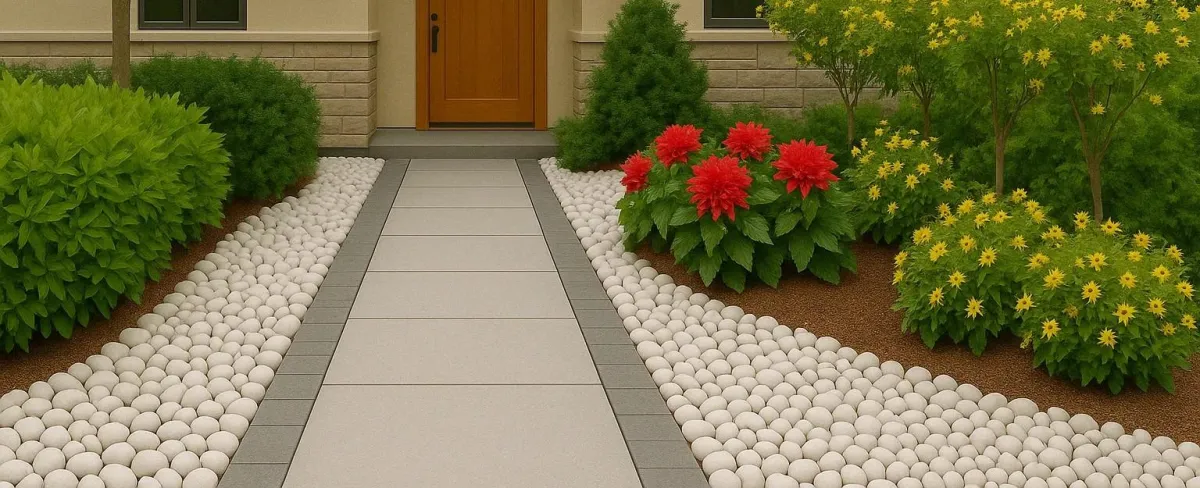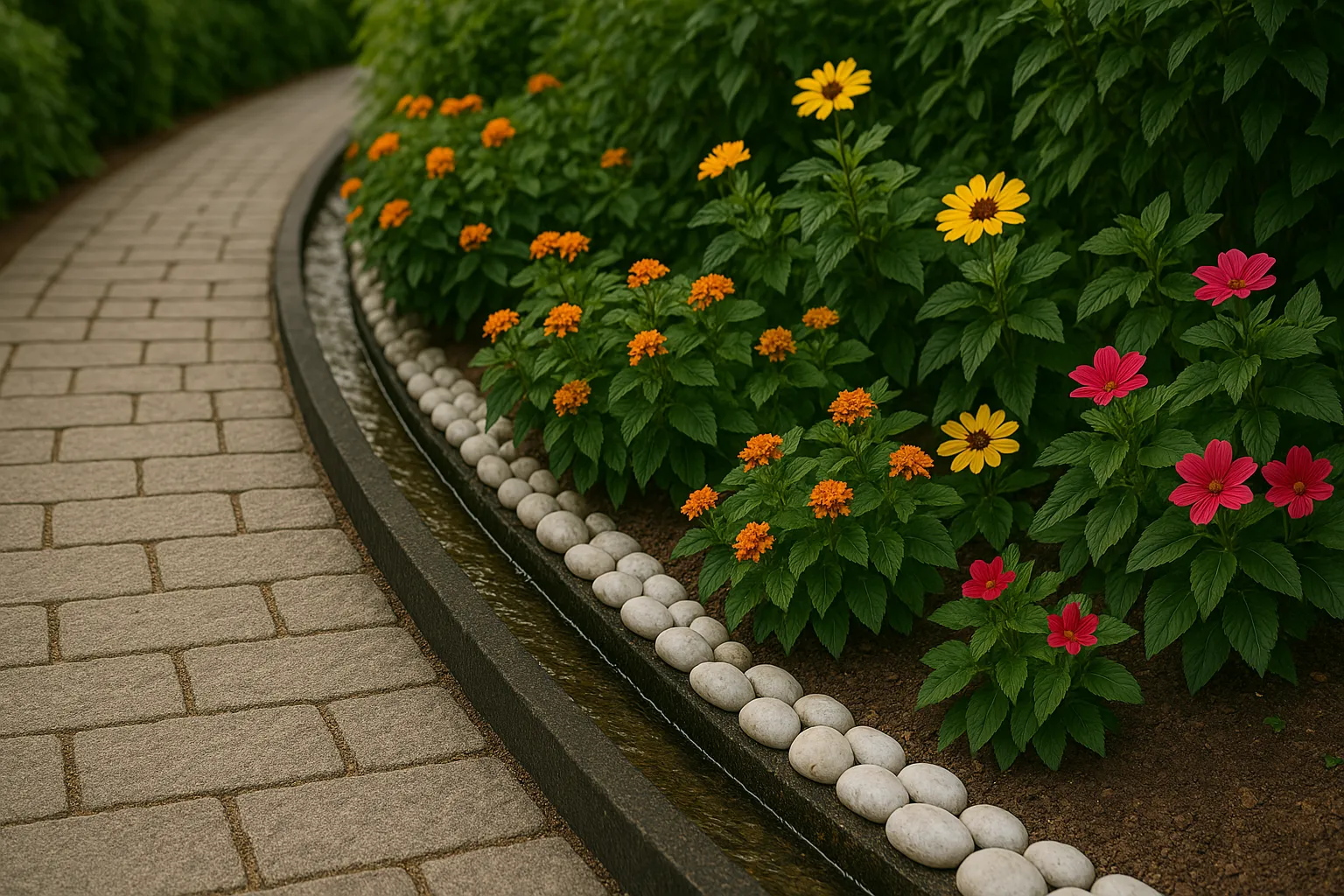
Top Landscaping Ideas to Elevate Your Curb Appeal
Introduction
In the quiet language of design, the front of your home speaks volumes. It’s the first impression, the opening note to the story your space tells—long before a guest steps inside.
Landscaping, when done with intention, is more than decoration. It’s transformation. From sunlit walkways lined with polished stones to serene corners framed by native greenery, each element has the power to shift how a space feels. Curb appeal isn’t just about beauty—it’s about resonance. It’s the moment someone pauses, exhales, and thinks: This feels right.
In this guide, we explore landscaping ideas that elevate that first impression into an experience—where nature, texture, and form come together in harmony. Whether you’re a designer seeking clean contrast or a homeowner curating serenity, these concepts are designed to inspire spaces that welcome with stillness and speak with style.
The Art of First Impressions: Understanding Curb Appeal

Curb appeal is more than a real estate buzzword—it’s the emotional gateway to your home or property. It’s what sets the tone before the door opens. A thoughtfully landscaped exterior tells visitors, clients, and even passersby that the space beyond is cared for, intentional, and refined.
At its core, curb appeal is about harmony. The balance of form and foliage. The contrast of textures. The subtle alignment of color, light, and space that creates visual calm. A minimalist stone border. A soft spill of lavender. The quiet curve of a path that draws you inward. These are not just design choices—they are emotional cues that invite presence.
When we think of curb appeal through the lens of design psychology, it becomes clear: first impressions are not just seen—they're felt. A well-composed landscape offers a moment of stillness, a reason to pause, and a sense of arrival.
Landscaping Ideas to Elevate Your Curb Appeal
1. Embrace Natural Stone Pathways
Pathways do more than guide your steps—they define how a space flows. A well-placed path made from natural stone introduces rhythm and structure to a landscape, inviting movement while anchoring the overall design.
Think of it as a conversation between form and function. Soft curves that suggest exploration. Clean lines that offer clarity. When designed intentionally, a stone pathway can be both practical and poetic.
Natural stones—especially those in neutral or white tones—bring texture without visual noise. Their organic shapes and slight imperfections mirror the beauty of nature itself. Whether flanked by grasses, nestled in gravel, or set within a sea of white pebbles, these paths offer understated elegance and enduring charm.
And beyond aesthetics, they offer durability. Unlike poured concrete or synthetic materials, natural stones age gracefully—developing character over time, just like the gardens they traverse.
2. Incorporate White Pebble Accents
Few elements in landscaping offer the serene clarity of pure white pebbles. Softly reflective, naturally tumbled, and striking in their simplicity, they transform ordinary beds and borders into meditative design statements.

White pebbles work best where contrast is needed—around deep green foliage, dark mulch, or architectural features. Their bright tone lifts the space, creating an interplay of light and texture that draws the eye without overwhelming the senses.
More than just filler, these stones are a design language of their own. Used beneath sculptural plants like agave or lavender, they create a gallery-like display. Lining pathways or defining garden zones, they bring cohesion and intentionality. And when paired with water features, their smooth surfaces shimmer—evoking quiet luxury.
For those curating minimalist landscapes or seeking that zen-like edge, white pebble accents are both grounding and elevating. They don’t just decorate a space—they center it.
3. Layered Planting for Depth and Interest
A landscape should unfold gently—like a well-composed photograph. Layered planting is the art of guiding the eye and enriching the experience through depth, dimension, and rhythm.
Begin with a backdrop: taller shrubs or ornamental grasses that frame the space. Then add a mid-layer—perennials, flowering plants, or sculptural foliage that bring color, texture, and seasonal shifts. Finally, ground the design with low-growing accents: creeping herbs, mosses, or decorative groundcovers that soften the edges and invite intimacy.
The magic is in the layering. It mimics nature’s own logic, where forests and meadows organize themselves in vertical harmony. This approach makes even small spaces feel lush and intentional—drawing visitors in, step by step.
Choose plants with varied textures and tones, but keep the palette restrained. Think soft greens against cool whites. Silver foliage brushing past pale stone. The goal is cohesion, not clutter—a calm canvas with enough variation to keep the eye curious.
4. Install Subtle Outdoor Lighting
As the sun dips and shadows lengthen, outdoor lighting becomes your landscape’s quiet narrator—softly revealing structure, silhouette, and mood.
Unlike the harshness of overhead floodlights, subtle lighting is about suggestion. Low-glow path lights, gentle uplighting on feature trees, and delicate spotlights under sculptural elements help maintain a peaceful ambiance while guiding the eye.
The goal is not to flood the space, but to define it. A wash of warm light across a white pebble bed. A gentle beam tracing the curve of a stone-edged walkway. The flicker of recessed step lights that blend into the setting like moonlight.
Great lighting extends the usability of your landscape while preserving its serenity. It also adds a layer of security, without compromising aesthetics. With thoughtful placement and restrained wattage, even a modest yard can become a nocturnal retreat—quiet, welcoming, and timeless.
5. Create a Focal Point with Sculptural Elements
Every landscape benefits from a moment of pause—a visual anchor that draws the eye and defines the space. Sculptural elements serve this role beautifully, offering presence without excess.
Think of a striking olive tree with weathered bark. A minimalist water basin reflecting the sky. Or a curated mound of white pebbles cradling a single boulder. These features don’t just fill space—they express intent.
Focal points work best when they feel integrated, not imposed. Place them where the eye naturally rests—at the end of a path, centered in a courtyard, or framed by plantings. They should speak softly but clearly, adding structure and story to the landscape.
Choose materials that echo the mood of the space: stone, steel, wood, or even living installations like bonsai or tall grasses. And always allow for breathing room. A sculptural element needs space to be noticed, to offer stillness, and to invite reflection.
6. Utilize Symmetry and Balance
Symmetry isn’t about rigidity—it’s about calm. In landscaping, balance creates a sense of order and refinement, subtly guiding the viewer’s eye and grounding the experience.
Consider matching planters on either side of an entryway. Mirrored rows of trimmed hedges. A centered path flanked by evenly spaced lighting. These elements invite harmony, giving even bold designs a quiet elegance.
Balance doesn’t have to be formal. Asymmetrical layouts can still feel stable if visual weight is thoughtfully distributed—perhaps a tall tree on one side, balanced by layered plantings and a sculptural boulder on the other.
The key is intentionality. When symmetry is used with restraint and purpose, it evokes sophistication and stillness—a perfect complement to minimalist hardscaping and curated materials like white pebbles.
7. Incorporate Sustainable Practices
True beauty endures—and the most elegant landscapes are often the ones rooted in care for the environment.
Incorporating sustainable landscaping practices not only conserves resources but also reinforces a sense of natural balance and responsibility. Start with native plants—they require less water, adapt to local climates, and support biodiversity. Choose drought-tolerant species that thrive without constant attention.
For ground cover and design accents, consider materials that do more than look good. White pebbles, for instance, help retain soil moisture, reduce weed growth, and offer a low-maintenance alternative to bark mulch—all while maintaining a clean, refined aesthetic.
Rain gardens, permeable pavers, and smart irrigation systems are modern tools that blend seamlessly into design while preserving the health of the land. Sustainability doesn’t mean sacrificing elegance—it means designing with intention and respect.
When you invest in green practices, your curb appeal becomes more than visual—it becomes ethical, responsible, and lasting.
Tailoring Ideas to Your Space
While inspiration is universal, every landscape tells a unique story—and the most impactful designs are those tailored to the space they inhabit.

Start by assessing your environment. What are the natural light patterns? Where does water collect? Which views deserve to be framed—and which should be softened or hidden? Observing these details helps you design with the landscape, not against it.
Next, consider your lifestyle. Are you creating a peaceful entry for a wellness space? A photogenic facade for design-conscious clients? Or a personal retreat that welcomes you home? Your goals will shape whether you lean into soft plantings, structural elements, or minimalist hardscapes.
Budget also plays a role—but it doesn’t have to limit beauty. Prioritize focal points and foundational upgrades that deliver high visual return. A single well-placed path or a clean border of white pebbles can transform a space more than a dozen mismatched accents.
Above all, trust your instincts. Spaces that feel good often look good—and curb appeal that’s authentic is always the most memorable.
Conclusion
Landscaping is more than an exterior upgrade—it’s a form of expression. A way to say, without words, this space matters.
From the timeless texture of white pebbles to the structured grace of stone pathways, each element you choose speaks to your values, your style, and your sense of calm. By layering plants with intention, illuminating features with soft light, and integrating focal points and sustainability, you create a design that feels both personal and elevated.
Whether you're a homeowner dreaming of curbside serenity, a designer refining a signature look, or a boutique brand creating visual impact—your landscape begins with vision and materials that support it.
White Pebble Wonders is here to help you shape that vision. With ethically sourced, snow-white stones that center your design and calm your space, your next transformation starts simply—with a single, beautiful detail.